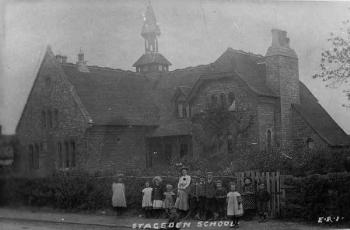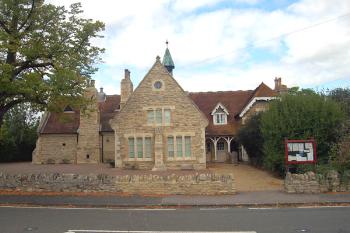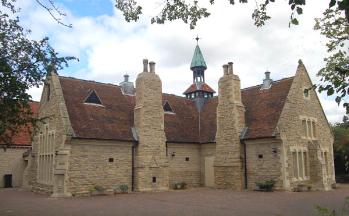Stagsden School

Stagsden School in the late 19th century [Z50/107/9]
1870-1903
The first Education Act was passed in 1870 (more correctly it was known as the Elementary Education Act). It was a milestone in the provision of education in Britain demonstrating central government's unequivocal support for education of all classes across the country. It also sought to secularise education by allowing the creation of School Boards. These were groups of representatives, elected by the local ratepayers and the Board had the powers to raise funds to form a local rate to support local education, build and run schools, pay the fees of the poorest children, make local school attendance compulsory between the ages of 5 and 13 and could even support local church schools, though in practice they replaced them, turning them into Board run schools (known as Board Schools). Naturally, and luckily for local historians, the Act required a questionnaire of local schools in 1870. Stagsden reported that there was "no efficient school" and that "accommodation for 130 children in Stagsden" was required noting: "If the Stagsden School is at once made efficient by the appointment of a certified teacher, no further accommodation will be required".
There is evidence from directories and other sources that Stagsden Free School was replaced by a National School in 1875. The school logbook [SDStagsden1] shows some of the subjects that children were taught during the Victorian period:
- 21st October 1882: "I have paid special attention to arithmetic of 1st class. Standard IV have had exercises in Square Measure. Boys in Standard II have had a good drill in motions, shape, etc of the earth. Boys in Standard III have had exercises upon the minerals and manufacturers of England".
- 16th January 1884: "There was a half holiday on Wednesday afternoon, the school being occupied by managers for the annual meeting. At the close of the meeting the following notice was given to me. “That the subjects taught in this school shall henceforth be confined to the obligatory subjects viz. Reading, Writing, Arithmetic and Needlework"".
In 1893 a list of object lessons for the younger children included, among others: "A Grocers Shop, Leather, A Slate, Milk and A Storm"

Stagsden school group in 1912 [Z50/142/89]
1903-1944
A land mark Education Act was passed in 1902, coming into effect in 1903. It disbanded the School Boards and gave day to day running of education to newly formed Local Education Authorities, usually the county council, as in Bedfordshire. The old Board Schools thus became Council Schools whilst the old National, British and other non-Board schools became known as Public Elementary Schools. Stagsden National School duly became a Public Elementary School.
Bedfordshire & Luton Archives & Records Service has a scrapbook of cuttings of visits made to most Bedfordshire Schools by School Inspectors for a period from just before the First World War through the inter-war years [E/IN1/1]. The first report dates to 1912, when average attendance was 80: "Excellent work has been done by the present master during the time he has been in charge. Order and tone are praiseworthy, the methods are good and in all classesvery creditable progress has been made. The Infants' are taught with much care and kindness and the little ones are being well prepared to take their place later on in the school for older scholars. The heatring of the rooms is very unsatisfactory and should receive the attention of the Managers and be improved before next winter". Then came the Great War and the inspection routine was disturbed, the next report not being made for ten years, it found: "This School is in good order and, considering that the Master teaches Classes 1 to 7 without assistance, its condition is in most respects quite creditable". The main concerns the inspector had were around writing.
The next report, in 1925, was devoted to buildings: "Eight windows out of nine in the main room break if they are opened, owing to the iron frames. They are not used, so the room is badly ventilated. The hearing apparatus is out of order - the chimney and back of furnace are broken or burnt through. The Boy's cloakroom is a darughty make shift; the Girls' and Infants' cloakroom is dark, and pegs want replacing and respacing. The offices [toilets] for the girls are a row of 4 individual seats in a dark, badly ventilated hut, with ivy growing through the roof. The boys' offices are similar - except there is no ivy. No washing accommodation is provided. The playground surface is very rough and does not drain well. Some of the guttering wants cleaning out - especially that over the girls' entrance. The premises need redecoration, especially perhaps, outside painting". A report a month later noted: "The tone of this school is, as usual, very satisfactory" however, "In Geography and Hitsory the teaching is such as should provide satisfactory results, but it is addresses too much to the brighter children, the consequence being that the others do not benefit so much as they otherwise would".
In 1926 this part of Bedfordshire was valued under he terms of the Rating Valuation Act 1925; every piece of land and building were inspected to determine the rates to be paid on them. Schools were no exception and the valuer visiting the schoolhouse, where the headteacher L.C.Knott lived, noted a stone and tile structure comprising a front room, living room and scullery with three bedrooms above; outside were an earth closet and a small garage. The valuer noted: "Water from buildings in village. Very substantial cottage. V.Nice"
The next Inspector's report was in 1929, average attendance 40: "The condition of this school has not varied much since the last report was written…There is a good deal of honest work done on rather old-fashioned lines". The same theme of little change was repeated in the inspection report of 1932, though adding: "but what change there is is in the direction of improvement", writing was a little better, and even speech, ever a bug-bear of inspectors: "…the speech, though still the aspiration is generally wrong and lips hardly move, is on the whole better". The inspector singled out handicraft, including girls' needlework, for special praise.
The final report in the book dates to 1938 which noted: "In appraising its work regard must be had to the difficulties presented by the unusual proportion - some forty per cent - of the total number of children who have already attended one or more schools. One boy is now in his sixth school" Whilst the older children were "quite satisfactory" the infants' attainments were "below the average…Both the Head Mistress and the class teacher are well aware of this. They are of the opinion that many of the childrten are naturally slow. the teacher is patient and sympathetic and may be trusted to do her best for the social and educational welfare of her charges". Finally, on a sour note: "The offices are most objectionable; in the absence of partition walls the children cannot be trained in habits of ordinary decency".
The school logbook [SDStagsden3] shows what life was like at school during the Second World War: 11th September 1939: "The school has been divided into four classes and accommodation provided for London evacuees". 34 children were admitted from London. The number of evacuees had fallen to 5 by April 1940 as the ‘phoney war’ meant that parents felt their children would be safe in London and wanted them to come home. In August 1940 a new group of children from Eastbourne in Sussex were evacuated to the area.
School routine was often disrupted by gas mask checks, air-raid drills and alerts: "21st November 1940 ‘Practically the whole afternoon has been spent in the refuge room. The alert sounded at 1:50 pm and the All Clear at 4:20 pm".
Children were given a holiday from school following the announcement of VE Day on 8th May 1945. The logbook records that "School closed today at 3:30 pm after the Prime Minister’s Declaration. The Rev Hunt kindly brought a wireless set to school so that the children could hear the Declaration and part of the speech that followed. He then conducted a short thanksgiving service".

The former Stagsden School July 2007
1944-1970s
The third of the great Education Acts was that of 1944 which established the principle of County Primary Schools for children up to the age of 11, at which time they took an examination to determine the nature of the secondary school they would attend until they were 15, the most academically able going to grammar schools, the rest to secondary or secondary modern schools. The act also created two types of successor to the public elementary schools - the Voluntary Aided and Voluntary Controlled schools. Voluntary Aided schools are those in which the Local Education Authority funds the school but the governing body is independent. Voluntary Controlled schools own their own buildings whilst the staff are employed directly by the governors. Stagsden became a Voluntary Aided County Primary School which, at some later point, became a school for infants only (i.e. children aged 4 to 7 years).

The former Stagsden Lower School in July 2007
Comprehensive Reorganisation and Closure
In the 1970s Bedfordshire County Council introduced comprehensive education, doing away with the 11+ examination and grammar schools and introducing a tier of school between the old County Primary and County Secondary Schools. Thus Lower Schools now taught children aged 4 to 9, Middle Schools from 9 to 13 and Upper Schools from 13 onwards. Stagsden duly became a Voluntary Aided Lower School but did not long service, falling rolls meaning that it, in common with a number of Bedfordshire schools, including nearby Stevington and Pavenham, was closed in 1983. The school buildings are currently [2007] the Village Hall, having been recently renovated.